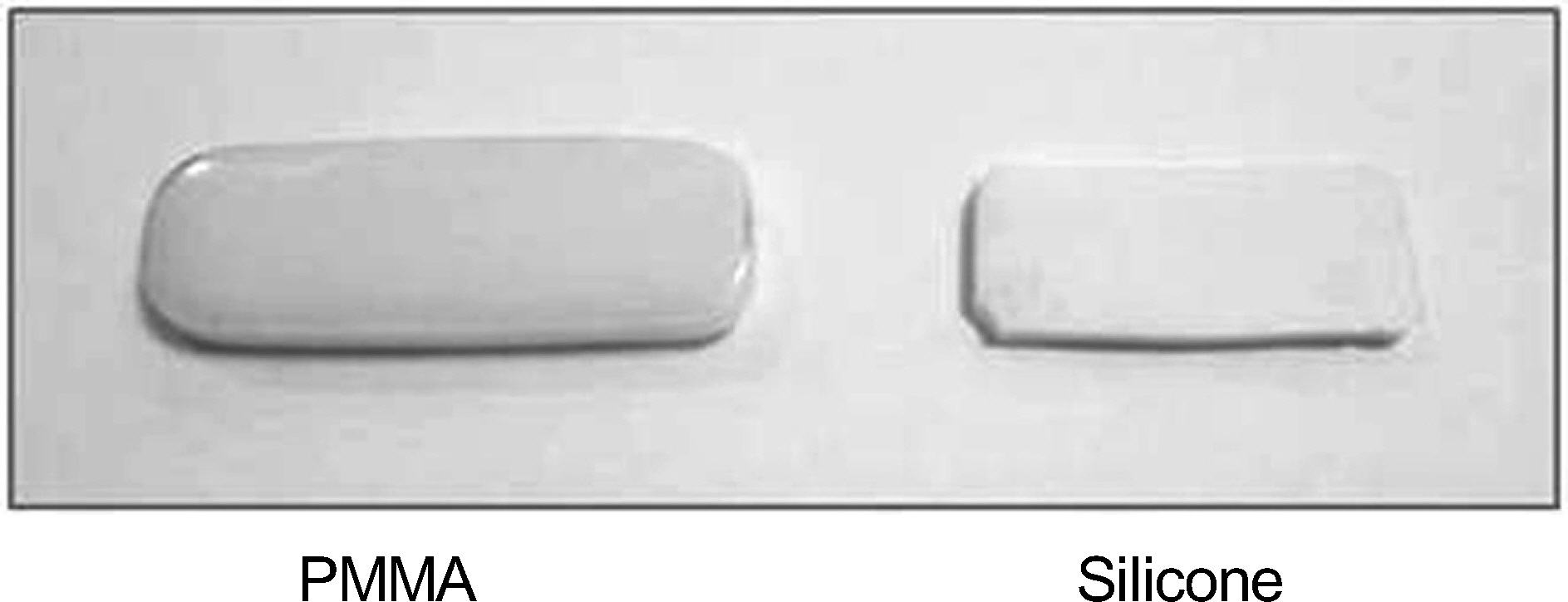J Korean Ophthalmol Soc.
2014 Dec;55(12):1745-1751. 10.3341/jkos.2014.55.12.1745.
Comparison of Wettability for Ocular Prosthesis Depending on Different Kinds of Artificial Tear Eye Drops
- Affiliations
-
- 1Department of Ophthalmology, Ajou University School of Medicine, Suwon, Korea. drkook@ajou.ac.kr
- KMID: 2338955
- DOI: http://doi.org/10.3341/jkos.2014.55.12.1745
Abstract
- PURPOSE
In this study we compared the surface wettability of ocular prosthesis and depositions depending on different types of artificial tear eye drops.
METHODS
The artificial tear eye drops contain sodium hyaluronate (HA) 0.1%, 0.18%, 0.3%, carboxylmethylcellulose sodium (CMC), hydroxymethylcelluose + dextran (HMC), propylene glycol + polyethylene glycol (PG), polysorbate 80 (PS) povidone (Pov) were evaluated. Flat rectangular parallelepiped blocks consisting of polymethylmethacrylate (PMMA) or silicone materials were made. One artificial tear eye drop was applied on the surface of two different blocks of artificial eyes using a 23-gauge needle. Then, the static method contact angle was measured by using a contact angle goniometer. To measure the deposits, a petri dish was covered with 3 mL of artificial tear eye drops and dried for 48 hours at room temperature. Then, the light transmittance at the center of the petri dish was measured to investigate the amount of the residue.
RESULTS
The contact angles of HA 0.1%, 0.18%, 0.3%, CMC, HMC, PG, PS and Pov on PMMA were 78.69degrees, 84.29degrees, 75.46degrees, 80.93degrees, 66.29degrees, 71.26degrees, 58.40degrees and 70.24degrees, respectively. The contact angles on silicone were 53.68degrees, 60.87degrees, 64.46degrees, 62.78degrees, 38.89degrees, 63.58degrees, 30.68degrees and 51.41degrees, respectively. The largest decrease in transparency was observed in the artificial tear eye drops containing HMC.
CONCLUSIONS
The wettability and deposits on the surface of ocular prosthesis can vary based on the components and concentration of artificial tear eye drops. The results from this study should be considered when choosing the right artificial tear eye drops for improving dry eye symptoms in patients wearing ocular prostheses.
MeSH Terms
-
Anophthalmos
Dextrans
Dry Eye Syndromes
Eye, Artificial*
Humans
Hyaluronic Acid
Needles
Ophthalmic Solutions*
Polyethylene Glycols
Polymethyl Methacrylate
Polysorbates
Povidone
Propylene Glycol
Silicones
Sodium
Tears*
Wettability*
Dextrans
Hyaluronic Acid
Ophthalmic Solutions
Polyethylene Glycols
Polymethyl Methacrylate
Polysorbates
Povidone
Propylene Glycol
Silicones
Sodium
Figure
Cited by 1 articles
-
Prosthesis Care in Long-term Prosthetic Eye Wearers
Hyun Yeon Kim, Keun Hae Kim
J Korean Ophthalmol Soc. 2019;60(3):217-222. doi: 10.3341/jkos.2019.60.3.217.
Reference
-
References
1. Lemp MA. Report of the National Eye Institute/Industry workshop on Clinical Trials in Dry Eyes. CLAO J. 1995; 21:221–32.2. Kim SE, Yoon JS, Lee SY. Tear measurement in prosthetic eye users with fourier-domain optical coherence tomography. Am J Ophthalmol. 2010; 149:602–7.e1.
Article3. Aragona P, Papa V, Micali A, et al. Long term treatment with sodium hyaluronate-containing artificial tears reduces ocular surface damage in patients with dry eye. Br J Ophthalmol. 2002; 86:181–4.
Article4. Asbell PA. Increasing importance of dry eye syndrome and the ideal artificial tear: consensus views from a roundTable discussion. Curr Med Res Opin. 2006; 22:2149–57.
Article5. Carré A, Woehl P. Spreading of silicone oils on glass in two geometries. Langmuir. 2006; 22:134–9.
Article6. Churaev NV, Sobolev VD. Wetting of low-energy surfaces. Adv Colloid Interface Sci. 2007; 134-5:15–23.
Article7. Molina R, Comelles F, Juliá MR, Erra P. Chemical Modifications on Human Hair Studied by Means of Contact Angle Determination. J Colloid Interface Sci. 2001; 237:40–6.
Article8. Tonge S, Jones L, Goodall S, Tighe B. The ex vivo wettability of soft contact lenses. Curr Eye Res. 2001; 23:51–9.
Article9. Cheng L, Muller SJ, Radke CJ. Wettability of silicone-hydrogel contact lenses in the presence of tear-film components. Curr Eye Res. 2004; 28:93–108.
Article10. Ketelson HA, Meadows DL, Stone RP. Dynamic wettability properties of a soft contact lens hydrogel. Colloids Surf B Biointerfaces. 2005; 40:1–9.
Article11. Raizada K, Rani D. Ocular prosthesis. Cont Lens Anterior Eye. 2007; 30:152–62.
Article12. Adler M, Miller R, Weaire D. Advances in colloid and interface science. Foreword. Adv Colloid Interface Sci. 2008; 137:1.13. Allen L, Kolder HE, Bulgarelli EM, Bulgarelli DM. Artificial eyes and tear measurements. Ophthalmology. 1980; 87:155–7.
Article14. Jang SY, Lee SY, Yoon JS. Meibomian gland dysfunction in longstanding prosthetic eye wearers. Br J Ophthalmol. 2013; 97:398–402.
Article15. Saedon H, Cheung D. Occult traumatic nasolacrimal duct obstruction causing anophthalmic socket contraction presenting 20 years later: a case report. Cutan Ocul Toxicol. 2008; 27:87–9.
Article16. Read ML, Morgan PB, Kelly JM, Maldonado-Codina C. Dynamic contact angle analysis of silicone hydrogel contact lenses. J Biomater Appl. 2011; 26:85–99.
Article17. Chau TT, Bruckard WJ, Koh PT, Nguyen AV. A review of factors that affect contact angle and implications for flotation practice. Adv Colloid Interface Sci. 2009; 150:106–15.
Article18. Yang J, Rose FR, Gadegaard N, Alexander MR. Effect of sessile drop volume on the wetting anisotropy observed on grooved surfaces. Langmuir. 2009; 25:2567–71.
Article19. Taylor M, Urquhart AJ, Zelzer M, et al. Picoliter water contact angle measurement on polymers. Langmuir. 2007; 23:6875–8.
Article20. Yuan Y, Lee TR. Contact angle and wetting properties. Surface Science Techniques. Springer Berlin Heidelberg. 2013; 51:3–34.21. Dutcher CS, Wexler AS, Clegg SL. Surface tensions of inorganic multicomponent aqueous electrolyte solutions and melts. J Phys Chem A. 2010; 114:12216–30.
Article
- Full Text Links
- Actions
-
Cited
- CITED
-
- Close
- Share
- Similar articles
-
- Evaluation of Changes in Tear Film Lipid Layer Thickness Using Ocular Surface Interferometer after Artificial Tear Application
- Therapeutic Effects of 0.03% Tacrolimus Eye Drops for Chronic Ocular Graft-Versus-Host Disease
- Changes in Total Tear Protein and Lipocalin Concentration According to Frequency of Artificial Tear Usage
- Analysis of Tear Meniscus Change after Strabismus Surgery Using Optical Coherence Tomography
- The Effect of Topical Rebamipide 2% in Managing Dry Eye Following Cataract Surgery






